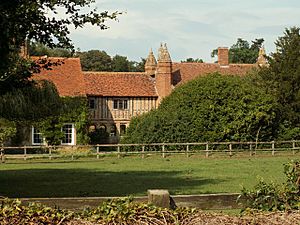West Stow Hall facts for kids
Quick facts for kids West Stow Hall |
|
|---|---|

West Stow Hall
|
|
| Type | Manor House |
| Location | West Stow |
| Area | Suffolk |
| Built | 16th century |
| Architectural style(s) | Tudor |
|
Listed Building – Grade I
|
|
| Official name: West Stow Hall | |
| Designated | 14 July 1955 |
| Reference no. | 1031269 |
| Lua error in Module:Location_map at line 420: attempt to index field 'wikibase' (a nil value). | |
West Stow Hall is an amazing old house in West Stow, Suffolk, England. It is a manor house built during the Tudor period, which was a long time ago! This beautiful building is close to a town called Bury St Edmunds. Work on the hall started around 1520. It was built for a man named Sir John Croftes. He had an important job working for Queen Mary Tudor.
Contents
History of West Stow Hall
Building the Hall
Sir John Croftes started building West Stow Hall around 1520. He was a very important person. He was the Master of the Horse for Mary Tudor. This meant he was in charge of all the queen's horses.
In 1526, Sir John Croftes rented the land where West Stow Hall stands. He rented it from the head of the Abbey in Bury St Edmunds. Later, he bought the land from the Crown. This happened after the Abbey was closed down.
The Gatehouse and Its Secrets
The gatehouse at West Stow Hall was once a separate building. It stood on its own, away from the main house. Around 1580, Sir John's grandson made a change. He built a special covered walkway. This walkway connected the gatehouse to the main house.
During the 1800s, the house was repaired and updated. Workers found something amazing in a room above the entrance. It was a wall-painting! This painting is called the 'Four Ages of Man'. Experts believe it was painted around 1575. It shows different stages of a person's life.
The Moat and Its Past
Many old manor houses had a moat around them. A moat is a deep, wide ditch filled with water. It was used to protect the house. West Stow Hall also had an original moat.
However, by 1840, the moat was filled in. It was no longer needed for protection. The gatehouse used to cross over the moat. It had two arches underneath it. You can still see the tops of these arches today. They are in the shrub border on the south side of the house.

